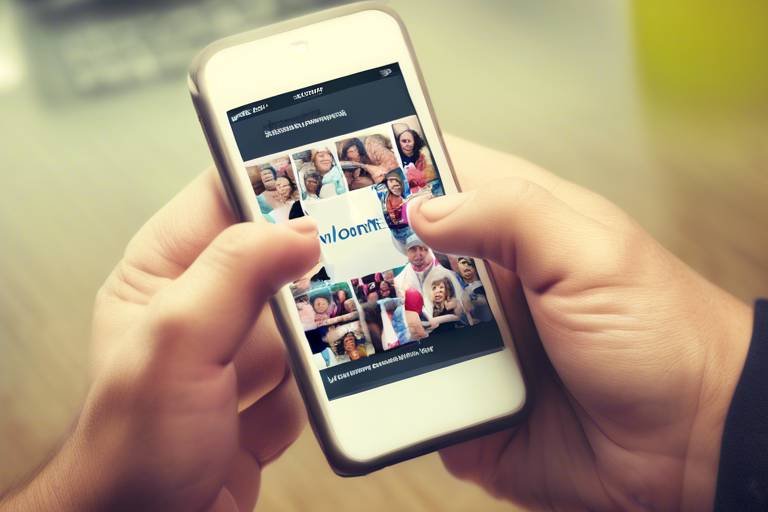How Technology is Reshaping Philanthropic Giving
In an era where technology is intertwined with nearly every aspect of our lives, it’s no surprise that it’s also making waves in the world of philanthropy. The way we give, the platforms we use, and even the causes we support are all being transformed by technological advancements. Imagine being able to donate to a cause you’re passionate about with just a few taps on your smartphone, or witnessing a social media campaign go viral, raising thousands of dollars in a matter of hours. This is not just a dream; it’s the reality of modern charitable giving. As we dive deeper into this topic, we’ll explore how technology is enhancing donor engagement, streamlining the donation process, and ultimately reshaping the landscape of philanthropic efforts.
Online giving platforms have revolutionized how donations are made, allowing for seamless transactions and greater accessibility for donors. No longer do you need to write a check or attend a fundraising gala to support your favorite charity. With just a few clicks, you can contribute to causes ranging from local shelters to global health initiatives. Popular platforms like GoFundMe, Kickstarter, and JustGiving have made it easier than ever for individuals and organizations to raise funds. These platforms not only provide a user-friendly interface for donations but also offer features like social sharing, which amplifies the reach of fundraising campaigns. The influence of these platforms on charitable giving is profound, as they connect donors directly with causes, fostering a sense of community and shared purpose.
Social media has become a powerful tool for fundraising, enabling organizations to reach wider audiences and engage with potential donors. Platforms like Facebook, Instagram, and Twitter allow nonprofits to share their stories, showcase their impact, and mobilize support in real-time. With the ability to go viral, a single post can lead to a surge of donations, making social media campaigns a game-changer in modern philanthropy. For instance, during crises or natural disasters, social media has proven to be an effective way to rally support quickly. Organizations can create compelling narratives that resonate with followers, turning them into advocates for their causes. The interconnectedness of social media means that every share, like, or comment can exponentially increase visibility and funding opportunities.
Crowdfunding has emerged as a significant trend in philanthropy, allowing individuals and organizations to pool resources for specific causes. Unlike traditional fundraising methods, crowdfunding democratizes the giving process, enabling anyone with a compelling story to seek support. This subsection explores successful crowdfunding campaigns that have not only met but exceeded their fundraising goals. For example, campaigns like the Ice Bucket Challenge not only raised millions for ALS research but also raised awareness about the disease, showing the power of collective giving. The implications for charitable giving are profound, as crowdfunding fosters a sense of ownership among donors, who feel directly connected to the outcomes of their contributions.
Analyzing notable crowdfunding campaigns reveals best practices and strategies that can inspire future initiatives. For instance, the "Fidget Spinner" campaign raised over $1 million in just a few days, demonstrating how innovative ideas can capture public interest. Similarly, the "Veronica Mars Movie" campaign showcased how fan engagement can drive funding for creative projects. These case studies highlight the importance of storytelling, community engagement, and social sharing in successful crowdfunding efforts.
Despite its advantages, crowdfunding presents challenges such as competition and donor fatigue. With so many campaigns vying for attention, it can be difficult for a new initiative to stand out. Additionally, as donors become inundated with requests for support, they may experience fatigue, leading to decreased contributions over time. Organizations must navigate these limitations by focusing on building long-term relationships with donors and creating compelling, authentic narratives that resonate with their audience.
With the increasing use of smartphones, mobile giving has gained traction as a convenient option for donors. The rise of mobile payment solutions like Apple Pay and Google Wallet has made it easier than ever to donate on-the-go. This subsection examines the growth of mobile donation technologies and their impact on fundraising. As more people rely on their phones for everyday transactions, the potential for mobile giving to increase charitable contributions is immense. Organizations that optimize their donation processes for mobile users can tap into a growing base of tech-savvy donors.
Data analytics is transforming how organizations approach fundraising by providing insights into donor behavior and preferences. By analyzing data, nonprofits can better understand who their donors are, what motivates them, and how to tailor their messaging to increase engagement. This section discusses how data-driven strategies enhance donor engagement and retention, allowing organizations to create personalized experiences that make donors feel valued and appreciated.
Leveraging data allows organizations to personalize interactions with donors, making them feel valued. For example, sending targeted emails based on past giving behavior can significantly increase the likelihood of future donations. This subsection explores how tailored communication can increase donor loyalty and contributions, ultimately leading to more successful fundraising campaigns.
Data analytics also aids in measuring the effectiveness of philanthropic initiatives. Organizations can track outcomes to demonstrate impact and attract future funding. This section discusses the importance of tracking outcomes and how data can be used to showcase the tangible results of donations, thereby encouraging continued support from donors.
Innovative technologies like blockchain and artificial intelligence are beginning to influence philanthropic efforts. This section explores how these technologies can enhance transparency and efficiency in charitable giving. As donors become more conscious of where their money goes, the demand for transparency in fundraising efforts is increasing. Technologies that can provide this transparency are likely to gain traction in the philanthropic sector.
Blockchain technology offers unprecedented transparency in transactions, which can build trust among donors. By providing a secure and immutable record of donations, blockchain can help organizations demonstrate accountability in their fundraising efforts. This subsection examines how organizations are adopting blockchain to improve accountability in fundraising, ensuring that every dollar is tracked and reported accurately.
Artificial intelligence is being utilized to analyze donor behavior and optimize engagement strategies. From chatbots that provide instant support to predictive analytics that forecast donor behavior, AI is transforming how organizations interact with their supporters. This section discusses AI's role in enhancing the donor experience and increasing contributions, showcasing how technology is making philanthropy more efficient and effective.
- What are some popular online giving platforms? Platforms like GoFundMe, JustGiving, and Kickstarter are widely used for charitable donations.
- How has social media impacted fundraising? Social media allows organizations to reach larger audiences and engage supporters in real-time, often leading to viral fundraising campaigns.
- What are the benefits of crowdfunding? Crowdfunding democratizes fundraising, allowing anyone to raise money for causes they care about, fostering community engagement.
- How can data analytics improve donor engagement? By analyzing donor behavior, organizations can personalize communication and tailor their fundraising strategies to better meet donor preferences.

The Rise of Online Giving Platforms
In recent years, the landscape of charitable donations has undergone a seismic shift, primarily due to the rise of online giving platforms. These platforms have made it easier than ever for individuals and organizations to contribute to causes they care about. No longer do donors need to write checks or attend fundraising events in person; with just a few clicks, they can make a significant impact from the comfort of their own homes. This convenience has opened the floodgates for donations, allowing charities to reach a broader audience than ever before.
One of the most noteworthy aspects of online giving platforms is their ability to provide a seamless transaction experience. Donors can quickly navigate through user-friendly interfaces, select their preferred causes, and complete their donations in mere minutes. This efficiency not only enhances the donor experience but also encourages repeat giving. In fact, many platforms now offer options for recurring donations, allowing supporters to set up automatic contributions on a weekly, monthly, or annual basis.
Some of the most popular online giving platforms include GoFundMe, Kickstarter, and JustGiving. Each of these platforms has carved out its niche in the philanthropic space:
| Platform | Focus Area | Key Features |
|---|---|---|
| GoFundMe | Personal and charitable causes | Easy setup, social sharing, no platform fees |
| Kickstarter | Creative projects | All-or-nothing funding, project showcases |
| JustGiving | Charity fundraising | Donation tracking, charity partnerships |
These platforms have not only democratized giving but have also fostered a sense of community among donors. Social sharing features allow users to promote their campaigns on various social media channels, amplifying their reach and encouraging friends and family to join in the giving. This social aspect of online giving has proven to be a game-changer, as it taps into the power of peer influence to drive contributions.
However, with so many options available, donors may feel overwhelmed by the choices. To combat this, many platforms have implemented recommendation algorithms that suggest causes based on the donor's previous giving history and interests. This personalized approach not only enhances the donor experience but also increases the likelihood of contributions, as individuals are more inclined to support causes that resonate with them personally.
As we move further into the digital age, the rise of online giving platforms represents just the tip of the iceberg. With advancements in technology and the growing acceptance of online transactions, we can expect to see even more innovative solutions emerge in the philanthropic space. The future of giving is not just about convenience; it's about creating meaningful connections between donors and the causes they support.

Impact of Social Media on Philanthropy
In today's digital age, social media has emerged as a game-changer in the world of philanthropy. It has transformed how organizations connect with potential donors, making it easier than ever to spread awareness about causes and encourage charitable giving. Imagine being able to reach thousands of people in just a few clicks—this is the power that social media brings to the table. Platforms like Facebook, Twitter, Instagram, and TikTok have become vital tools for non-profits, enabling them to share their stories, showcase their impact, and engage with supporters on a personal level.
One of the most significant advantages of social media is its ability to create a sense of community among donors and beneficiaries. When organizations share compelling stories or impactful images, they tap into the emotions of their audience, which can lead to increased engagement and donations. For instance, a heartwarming video showcasing the direct impact of a donation can evoke empathy and spur viewers to contribute to the cause. Furthermore, the interactive nature of social media allows for real-time communication, fostering a two-way dialogue between charities and their supporters.
Moreover, social media campaigns often go viral, reaching audiences far beyond the non-profit's immediate network. This phenomenon can lead to a surge in donations, as seen in various successful campaigns. For example, the Ice Bucket Challenge raised over $115 million for ALS research in just a few months, demonstrating the immense potential of social media to mobilize support for a cause. Organizations can leverage trending hashtags, challenges, and influencer collaborations to amplify their message and reach a broader audience.
However, while social media offers incredible opportunities, it's essential for organizations to be strategic in their approach. Here are a few key considerations:
- Content Quality: High-quality, engaging content is crucial. Posts should be visually appealing and tell a compelling story.
- Consistency: Regular posting keeps the audience engaged and informed. A consistent presence helps maintain interest in the organization’s mission.
- Engagement: Actively responding to comments and messages fosters community and shows donors that their contributions are valued.
In summary, social media has revolutionized the landscape of philanthropy by enhancing communication, building communities, and enabling organizations to reach wider audiences. As more people turn to these platforms for information and connection, the potential for impactful fundraising continues to grow, making it an indispensable tool for modern charitable efforts.
Q1: How can social media increase donations for non-profits?
A1: Social media increases donations by expanding reach, engaging communities, and sharing impactful stories that resonate with potential donors.
Q2: What types of content work best for fundraising on social media?
A2: Visual content, such as videos and images that tell a compelling story, along with testimonials and updates on the impact of donations, tend to perform best.
Q3: Can small organizations benefit from social media fundraising?
A3: Absolutely! Small organizations can leverage social media to build awareness, engage local communities, and reach potential donors without a large budget.

Crowdfunding Initiatives
Crowdfunding has emerged as a significant trend in philanthropy, revolutionizing how individuals and organizations gather resources for specific causes. Imagine a world where a small idea can turn into a monumental movement, all thanks to the collective power of the internet. Crowdfunding platforms like GoFundMe, Kickstarter, and Indiegogo have made it possible for anyone with a vision to reach out to the masses and ask for support. This democratization of fundraising has not only opened doors for innovative projects but has also created a sense of community around various causes.
One of the most remarkable aspects of crowdfunding is its ability to engage a diverse audience. No longer are donors limited to wealthy individuals or corporations; instead, everyday people can contribute whatever they can afford, whether it’s a dollar or a thousand. This shift has led to an explosion of grassroots campaigns that tackle everything from environmental issues to social justice initiatives. In fact, a study by the Stanford Social Innovation Review found that crowdfunding has raised over $34 billion worldwide, showcasing its profound impact on charitable giving.
Successful crowdfunding initiatives often share common characteristics that contribute to their effectiveness. These include:
- Compelling Storytelling: A captivating narrative can draw potential donors in, making them feel personally invested in the cause.
- Clear Goals and Transparency: Clearly defined funding goals and transparent use of funds build trust with donors.
- Engaging Visuals: High-quality images and videos can significantly enhance the appeal of a campaign.
- Community Engagement: Actively involving supporters through updates and interactions fosters a sense of belonging and encourages sharing.
Let’s take a look at some notable examples of crowdfunding campaigns that have achieved remarkable fundraising success:
| Campaign Name | Amount Raised | Cause | Platform |
|---|---|---|---|
| Ice Bucket Challenge | $115 million | ALS Awareness | |
| Veronica Mars Movie | $5.7 million | Film Production | Kickstarter |
| Exploding Kittens | $8.7 million | Card Game | Kickstarter |
However, while crowdfunding presents exciting opportunities, it is not without its challenges. The sheer volume of campaigns can lead to competition for donor attention, resulting in what some call "donor fatigue." Potential contributors may feel overwhelmed by the number of requests they receive, making it crucial for organizations to differentiate their campaigns. Moreover, maintaining momentum throughout the campaign duration is essential to keep supporters engaged and motivated to contribute.
In conclusion, crowdfunding initiatives have transformed the landscape of philanthropy, enabling a broader range of voices to be heard and supported. By harnessing the power of community and technology, organizations can leverage crowdfunding to not only raise funds but also to create a movement around their cause. As we continue to explore this exciting frontier, understanding the nuances of successful crowdfunding strategies will be key to harnessing its full potential.

Case Studies of Successful Campaigns
When it comes to understanding the impact of crowdfunding in philanthropy, examining successful campaigns provides invaluable insights. These campaigns not only showcase innovative fundraising strategies but also highlight the emotional connections that can be forged between donors and causes. One standout example is the Ice Bucket Challenge, which took social media by storm in 2014. This viral campaign raised over $115 million for ALS research in just a few months. It combined the elements of fun, challenge, and social sharing, making it easy for participants to engage and donate while spreading awareness about the disease.
Another remarkable case is GoFundMe's campaign for the Las Vegas Victims Fund, established after the tragic shooting in 2017. Within a few weeks, the campaign raised over $31 million, showcasing how community solidarity can mobilize support quickly in times of crisis. The campaign's success was largely due to its emotional appeal, transparent allocation of funds, and the ability to share personal stories that resonated with potential donors.
Moreover, the Movember Foundation has effectively utilized crowdfunding to raise awareness and funds for men's health issues. Each November, men around the world grow mustaches to spark conversations about prostate cancer and mental health. The campaign not only raises significant funds but also encourages community involvement and engagement through local events and challenges. This grassroots approach has turned a simple idea into a global movement, demonstrating how personal involvement can amplify fundraising efforts.
To further illustrate the effectiveness of these campaigns, we can look at a table that summarizes key elements of their success:
| Campaign Name | Amount Raised | Key Strategy | Impact |
|---|---|---|---|
| Ice Bucket Challenge | $115 million | Viral social media engagement | Increased awareness of ALS |
| Las Vegas Victims Fund | $31 million | Community solidarity and emotional appeal | Support for victims and families |
| Movember Foundation | $100 million+ (annually) | Grassroots involvement and local events | Awareness for men's health issues |
These case studies reveal that successful crowdfunding campaigns share several common attributes: they leverage emotional storytelling, utilize social media effectively, and create a sense of community among donors. By understanding these elements, organizations can better design their own campaigns to maximize engagement and contributions. The power of crowdfunding lies not just in the funds raised but in the connections formed, the awareness generated, and the lives changed as a result.
Q: What is crowdfunding?
A: Crowdfunding is the practice of raising small amounts of money from a large number of people, typically via the internet, to fund a project or cause.
Q: How can I start my own crowdfunding campaign?
A: To start a crowdfunding campaign, choose a platform, set a clear goal, create a compelling story, and promote your campaign through social media and other channels.
Q: What makes a crowdfunding campaign successful?
A: Successful crowdfunding campaigns usually have a strong emotional appeal, clear goals, effective marketing strategies, and a community-driven approach.
Q: Are there any risks involved in crowdfunding?
A: Yes, risks include competition from other campaigns, potential donor fatigue, and the challenge of meeting fundraising goals.

Challenges and Limitations
While crowdfunding has undoubtedly opened new avenues for philanthropic giving, it is not without its . One of the most significant hurdles is the sheer volume of campaigns vying for attention. With thousands of initiatives launching daily, potential donors often feel overwhelmed by choices, leading to what many experts refer to as donor fatigue. This phenomenon occurs when donors become desensitized to requests for contributions, making them less likely to engage with new campaigns.
Moreover, the competitive landscape can create difficulties for newer or smaller organizations that struggle to stand out. Without a solid marketing strategy or a unique value proposition, these initiatives may fail to gain traction, resulting in disappointing fundraising results. It's crucial for organizations to not only present a compelling story but also to effectively communicate their impact. This is where clear messaging becomes pivotal. If potential donors cannot quickly grasp the significance of a project, they are less likely to contribute.
Another challenge lies in the trust factor. Many donors are increasingly cautious about where their money goes, particularly with the rise of fraudulent campaigns. The internet has made it easier for scams to proliferate, causing skepticism among potential contributors. Organizations must work diligently to establish their credibility and demonstrate transparency in how funds will be utilized. This can be achieved through regular updates, detailed reports, and, ideally, third-party endorsements.
Additionally, the technological divide cannot be overlooked. While mobile giving and online platforms have made donations more accessible, not everyone has equal access to technology. Older generations, individuals in rural areas, or those without reliable internet connections may find it challenging to participate in these new giving trends. Thus, organizations must consider inclusive strategies that cater to a broader audience, ensuring that no one is left behind in the digital age.
In summary, while crowdfunding offers exciting opportunities for philanthropic giving, organizations must navigate several challenges to maximize their potential. By addressing donor fatigue, establishing trust, and ensuring inclusivity, they can create a more effective and sustainable fundraising environment.
- What is donor fatigue? Donor fatigue occurs when potential contributors become overwhelmed by numerous fundraising requests, leading to decreased engagement.
- How can organizations build trust with donors? Organizations can build trust by being transparent about how funds are used, providing regular updates, and showcasing their impact.
- What are some strategies to stand out in a crowded crowdfunding space? Effective storytelling, a unique value proposition, and strategic marketing can help organizations differentiate themselves from others.
- How can organizations ensure inclusivity in their fundraising efforts? Organizations can ensure inclusivity by offering multiple ways to donate, including offline options, and by reaching out to diverse communities.

Mobile Giving Trends
In recent years, the landscape of charitable giving has experienced a remarkable shift, largely driven by the proliferation of smartphones and mobile technology. With just a few taps on their screens, donors can now contribute to their favorite causes from virtually anywhere in the world. This convenience has led to a significant increase in mobile giving, transforming the way individuals and organizations approach philanthropy. Have you ever thought about how easy it is to donate while waiting in line for coffee? That’s the power of mobile giving!
Mobile giving isn’t just a trend; it’s a fundamental change in how donations are made. According to recent statistics, mobile donations have surged, accounting for a substantial percentage of total online giving. Organizations are leveraging mobile-friendly donation platforms and applications to facilitate this process, making it easier for donors to contribute. Imagine being able to support a cause with a simple text message or a quick click on an app—this is the reality of mobile giving today.
One of the key drivers behind the rise of mobile giving is the enhanced user experience that these platforms provide. Many organizations are now adopting responsive design to ensure that their websites and donation pages are accessible and user-friendly on mobile devices. This means that whether you’re on a tablet, smartphone, or even a smartwatch, you can easily navigate through the donation process without any hassle. It’s like having a donation box in your pocket, ready to go whenever inspiration strikes!
Moreover, the implementation of mobile wallets and payment solutions, such as Apple Pay, Google Pay, and Venmo, has further simplified the donation process. Donors can securely store their payment information and make transactions with just a few clicks. This not only enhances convenience but also boosts donor confidence, as mobile wallets often come with robust security measures. Imagine the peace of mind knowing your financial information is safe while you’re making a difference!
However, while mobile giving presents incredible opportunities, it’s essential to acknowledge the challenges that come with it. For instance, organizations must ensure that their mobile donation platforms are optimized for performance and security. A slow-loading page or a complicated donation process can deter potential donors. It’s crucial to continually test and improve these platforms to provide the best possible experience. After all, in the world of mobile giving, every second counts!
In addition, organizations must also be aware of the changing preferences of younger donors, who are often more inclined to support causes through mobile channels. This demographic is not only tech-savvy but also values transparency and accountability. Therefore, charities that can showcase their impact through mobile platforms are likely to attract and retain these younger supporters. It’s a win-win situation: donors feel connected to their contributions, and organizations benefit from increased loyalty and support.
As we look to the future, it’s clear that mobile giving will continue to evolve. With advancements in technology, we can expect even more innovative solutions that enhance the donor experience and streamline the giving process. Whether it’s through augmented reality experiences that showcase the impact of donations or AI-driven suggestions that personalize giving opportunities, the possibilities are endless. So, the next time you think about making a donation, remember that your smartphone could be the key to unlocking a world of philanthropy at your fingertips!
- What is mobile giving? Mobile giving refers to the process of making donations through mobile devices, such as smartphones and tablets, often via apps or text messages.
- How can I ensure my mobile donation is secure? Look for platforms that utilize secure payment methods and encryption to protect your financial information.
- Are there any fees associated with mobile giving? Some platforms may charge transaction fees. It's best to review the terms of service before donating.
- Can I track my mobile donations? Yes, many organizations provide donors with receipts and updates on how their contributions are being used.
- Is mobile giving only for young people? No, while younger donors may be more inclined to use mobile giving, people of all ages are increasingly adopting this method.

Data Analytics in Philanthropy
The world of philanthropy is evolving at a breakneck pace, and one of the most significant drivers of this change is data analytics. Organizations are no longer just relying on gut feelings or traditional methods to gauge donor engagement; instead, they are leveraging data to make informed decisions that can lead to more effective fundraising strategies. This shift is akin to upgrading from a flip phone to a smartphone—suddenly, there's a wealth of information at your fingertips, allowing for greater connectivity and understanding of your audience.
Data analytics provides invaluable insights into donor behavior, preferences, and trends. By analyzing patterns in giving, organizations can tailor their approaches to resonate with their supporters. For instance, if data reveals that a significant portion of donations comes from a specific demographic, organizations can customize their marketing strategies to better appeal to this group. This level of personalization not only enhances the donor experience but also boosts the likelihood of increased contributions.
Moreover, data analytics can help organizations segment their donor base effectively. Imagine trying to find a needle in a haystack—without data, identifying your most engaged donors would be nearly impossible. However, with the right analytics tools, nonprofits can categorize their donors based on various criteria such as donation history, engagement levels, and even social media interactions. This segmentation allows for targeted campaigns, ensuring that each donor receives communications that are relevant and meaningful to them.
One of the most compelling aspects of data analytics in philanthropy is its ability to measure impact and outcomes. Organizations can track how funds are being utilized and the tangible results they produce. For example, if a nonprofit is raising funds for a specific project, data analytics can help them assess whether the project is meeting its goals. This not only demonstrates accountability to donors but also helps in crafting future campaigns that can attract more funding. In fact, organizations that can effectively communicate their impact are often more successful in securing ongoing support.
To illustrate the importance of data analytics, consider the following table that highlights key benefits:
| Benefit | Description |
|---|---|
| Enhanced Donor Engagement | Utilizing data to personalize communication, leading to stronger relationships with donors. |
| Informed Decision-Making | Data-driven insights allow organizations to make strategic choices that align with donor preferences. |
| Impact Measurement | Tracking outcomes to demonstrate effectiveness and attract future funding. |
| Segmentation | Identifying different donor groups for targeted campaigns that resonate with specific audiences. |
As we move forward, the integration of data analytics in philanthropy is not just a trend; it's becoming a necessity. Organizations that embrace these technologies will not only improve their fundraising outcomes but also foster a deeper connection with their donors. In a world where every dollar counts, understanding the intricacies of donor behavior through data is invaluable. So, the next time you consider making a donation, remember that your contribution is more than just a number; it’s part of a larger narrative that organizations are eager to understand and enhance.
- How can data analytics improve donor retention? By analyzing donor behavior, organizations can tailor their communications and engagement strategies, making donors feel valued and appreciated.
- What tools are commonly used for data analytics in philanthropy? Many organizations use platforms like Google Analytics, Salesforce, and specialized nonprofit management software to gather and analyze data.
- Is data privacy a concern in philanthropy? Yes, organizations must ensure they adhere to data protection regulations and respect donor privacy while utilizing analytics.

Personalization of Donor Experiences
In today's fast-paced digital world, where every click and interaction counts, personalization has become the secret sauce for successful fundraising. Imagine walking into your favorite coffee shop, and the barista already knows your name and your usual order. That's the kind of experience donors crave when they engage with philanthropic organizations. By leveraging data analytics, charities can create tailored experiences that resonate with individual donors, making them feel valued and appreciated. This not only enhances the donor's experience but also fosters a deeper emotional connection to the cause.
Personalized communication can take many forms. For instance, organizations can segment their donor base and tailor messages based on previous interactions or donation history. This means that someone who has consistently donated to environmental causes might receive updates about specific projects related to wildlife conservation, while a donor who supports education initiatives might get insights into the impact of their contributions on local schools. By doing this, organizations can ensure that their messages are relevant and engaging, which significantly increases the likelihood of ongoing support.
Moreover, personalization goes beyond just emails or newsletters. It can also encompass donor recognition strategies. For example, creating personalized thank-you videos from beneficiaries or sending handwritten notes can leave a lasting impression. When donors see the tangible impact of their contributions and feel recognized for their generosity, they are more likely to continue supporting the organization in the future.
To illustrate the effectiveness of personalized donor experiences, consider the following table that outlines different personalization strategies and their potential benefits:
| Personalization Strategy | Benefits |
|---|---|
| Segmented Email Campaigns | Increased open and click-through rates, higher engagement levels. |
| Personalized Thank-You Messages | Strengthened donor relationships, improved donor retention. |
| Impact Reports Tailored to Donor Interests | Enhanced understanding of impact, increased likelihood of future donations. |
In addition to these strategies, organizations can utilize technology to create a more immersive donor experience. For instance, using virtual reality (VR) to showcase the impact of donations can provide a powerful, emotional connection to the cause. Imagine donors being able to "walk through" a community project they funded, seeing firsthand the difference their contributions make. This kind of technology not only personalizes the experience but also amplifies the emotional resonance of giving.
Ultimately, the key to successful personalization lies in understanding your donors. What are their interests? What motivates them to give? By answering these questions and implementing personalized strategies, organizations can create a loyal donor base that feels connected and committed to the cause. In a world where attention is fleeting, personalization is not just a nice-to-have; it's a necessity for any organization looking to thrive in the philanthropic landscape.
- Why is personalization important in donor engagement?
Personalization helps create a deeper emotional connection between donors and the organization, leading to increased loyalty and ongoing support. - How can organizations collect data for personalization?
Organizations can collect data through donation history, surveys, and engagement metrics to better understand donor preferences and interests. - What are some effective ways to personalize communication?
Segmented email campaigns, personalized thank-you notes, and tailored impact reports are all effective methods for personalizing communication with donors.

Measuring Impact and Outcomes
In the world of philanthropy, demonstrating the effectiveness of initiatives is crucial. Donors want to know that their contributions are making a tangible difference. This is where the power of data analytics comes into play. By utilizing advanced analytics, organizations can track various metrics that reflect the impact of their programs. For instance, measuring the number of beneficiaries served, the improvement in their quality of life, or the overall reach of a campaign can provide valuable insights.
Moreover, organizations can employ key performance indicators (KPIs) to assess their effectiveness. These KPIs might include:
- Funds raised versus goals set
- Donor retention rates
- Engagement levels on social media platforms
- Feedback from beneficiaries
To illustrate the importance of measuring outcomes, consider a charity that provides education to underprivileged children. By analyzing data, they can determine how many children have successfully graduated from their programs and how many have gone on to pursue higher education. This not only showcases the charity's success but also serves as a compelling story for future fundraising efforts.
Additionally, organizations can utilize impact reports to communicate their achievements to stakeholders. These reports often include quantitative data, such as the number of meals provided or the number of families supported, alongside qualitative narratives that highlight personal stories of change. This combination of data and storytelling creates a powerful narrative that resonates with potential donors.
Furthermore, tracking outcomes can lead to continuous improvement. By analyzing what works and what doesn’t, organizations can pivot their strategies to enhance their effectiveness. This iterative process ensures that philanthropic efforts are not just well-intentioned but also impactful.
In conclusion, measuring impact and outcomes is not merely a box to check; it's a vital component of successful philanthropy. By leveraging data analytics, organizations can not only demonstrate their effectiveness but also build trust with donors, ensuring sustained support for their missions.
- Why is measuring impact important in philanthropy?
Measuring impact helps organizations demonstrate the effectiveness of their initiatives, build trust with donors, and secure future funding. - What are some common metrics used to measure philanthropic impact?
Common metrics include funds raised, donor retention rates, and the number of beneficiaries served. - How can organizations improve their measurement strategies?
Organizations can improve by utilizing advanced data analytics, setting clear KPIs, and regularly reviewing their strategies based on outcomes. - What role do impact reports play in fundraising?
Impact reports communicate achievements to stakeholders, combining quantitative data with personal stories to engage potential donors.

Emerging Technologies in Philanthropy
As we delve into the realm of philanthropy, it's impossible to ignore the transformative power of emerging technologies. Innovations such as blockchain and artificial intelligence (AI) are not just buzzwords; they are reshaping how organizations approach charitable giving. Imagine a world where every donation is tracked with absolute transparency, where donors can see exactly how their contributions are making an impact. This is the future that technology is paving for philanthropy, and it's happening right now.
One of the most exciting advancements is blockchain technology. Traditionally, many donors have expressed concerns about the transparency of charitable organizations. With blockchain, each transaction is recorded on a public ledger, making it nearly impossible to manipulate data. This level of transparency builds trust, which is crucial in encouraging more people to donate. For instance, if a donor can see that their funds are directly supporting a specific project, they are more likely to contribute again in the future.
Organizations are beginning to adopt blockchain to enhance accountability. For example, some nonprofits are using blockchain to track the flow of funds in real-time, providing donors with updates on how their money is being utilized. This not only fosters trust but also encourages a sense of community among donors, as they can see the collective impact of their contributions. Imagine being part of a project where you can trace how every dollar is spent—this is the kind of accountability that blockchain offers.
On the other hand, artificial intelligence is revolutionizing donor engagement. By analyzing vast amounts of data, AI can identify patterns in donor behavior, preferences, and engagement levels. This allows organizations to tailor their communication strategies to meet the needs of individual donors. For instance, AI can help identify which donors are likely to respond positively to certain types of campaigns, enabling nonprofits to customize their outreach efforts. This personalized approach not only enhances the donor experience but also increases the likelihood of contributions.
Moreover, AI can predict future giving trends by analyzing past donation data. This predictive analytics capability enables organizations to plan their fundraising strategies more effectively. For example, if AI indicates that a particular demographic is likely to contribute during certain times of the year, organizations can prepare targeted campaigns to maximize donations during those periods. It's like having a crystal ball that helps nonprofits navigate the complex landscape of fundraising.
As we consider the implications of these technologies, it's essential to acknowledge that they also come with challenges. Not all organizations may have the resources or technical expertise to implement blockchain or AI solutions effectively. However, those that do embrace these innovations stand to gain a significant advantage in the competitive world of philanthropy.
In conclusion, the integration of emerging technologies like blockchain and AI in philanthropy is not just a trend—it's a revolution. These tools are enhancing transparency, fostering trust, and personalizing donor experiences. As we move forward, it will be fascinating to see how these technologies continue to evolve and shape the future of charitable giving.
- What is blockchain technology in philanthropy? Blockchain technology is a decentralized digital ledger that records transactions across many computers securely and transparently, ensuring that the data cannot be altered retroactively.
- How does AI enhance donor engagement? AI analyzes donor data to identify patterns and preferences, allowing organizations to tailor their communication and outreach strategies to individual donors, thereby increasing engagement and contributions.
- Are there challenges in implementing these technologies? Yes, challenges may include the need for technical expertise, resource allocation, and the initial investment required to adopt these technologies effectively.

Blockchain for Transparency
In the realm of philanthropy, transparency is paramount. Donors want to know where their money is going and how it’s being used. This is where blockchain technology steps in, offering a revolutionary solution to the age-old problem of trust in charitable giving. Imagine a world where every transaction is recorded in a secure, immutable ledger that anyone can verify. Sounds like a dream, right? Well, it’s becoming a reality!
Blockchain operates on a decentralized network, meaning that no single entity controls the data. This decentralization is crucial as it reduces the risk of fraud and mismanagement of funds. When donations are made through a blockchain-enabled platform, each transaction is documented in real-time, ensuring that donors can trace exactly how their contributions are being utilized. This level of transparency not only builds trust but also encourages more people to give, knowing that their money is being handled responsibly.
For organizations, adopting blockchain can lead to improved accountability. By providing a clear audit trail of funds, charities can demonstrate their commitment to ethical practices, which is increasingly important in today’s socially conscious market. Donors are more likely to support organizations that can prove their impact, and blockchain offers a straightforward way to showcase this. The potential for increased donor confidence is enormous, as studies suggest that transparency can lead to higher donation amounts.
Moreover, the benefits of blockchain extend beyond just tracking donations. It can also streamline the fundraising process. Traditional methods often involve lengthy verification processes and can incur significant transaction fees. With blockchain, these costs can be minimized, allowing more funds to go directly to the cause. Imagine a scenario where a charity can allocate 100% of donations to their projects instead of spending a chunk on administrative fees. This is the kind of efficiency that blockchain brings to the table.
However, while the advantages are compelling, it’s essential to acknowledge the challenges that come with implementing blockchain in philanthropy. The technology is still relatively new, and many organizations may lack the technical expertise to adopt it effectively. Additionally, there are concerns about the energy consumption associated with some blockchain networks, particularly those using proof-of-work mechanisms. Nevertheless, as technology evolves, solutions to these issues are being developed, paving the way for broader adoption.
In conclusion, blockchain technology is not just a buzzword; it’s a game-changer for the philanthropic sector. By enhancing transparency and accountability, it has the potential to transform how charities operate and how donors engage with them. As we look to the future, it’s exciting to envision a world where every charitable contribution is not only impactful but also traceable, creating a more trustworthy and efficient ecosystem for giving.
- What is blockchain technology? Blockchain is a decentralized digital ledger that records transactions across many computers so that the record cannot be altered retroactively.
- How does blockchain enhance transparency in philanthropy? It allows donors to track their contributions in real-time, ensuring funds are used as intended.
- Are there any downsides to using blockchain in philanthropy? Yes, challenges include the need for technical expertise and concerns about energy consumption.
- Can blockchain increase donor confidence? Absolutely! Transparency builds trust, which can lead to increased donations.

AI in Donor Engagement
Artificial Intelligence (AI) is transforming the landscape of donor engagement in ways that were once unimaginable. Imagine having a virtual assistant that not only understands your preferences but also knows when you’re likely to give and to which causes. This is the power of AI in philanthropy. By analyzing vast amounts of data, AI can identify patterns in donor behavior, helping organizations tailor their outreach strategies effectively. For instance, AI algorithms can predict which donors are most likely to respond positively to specific campaigns, allowing nonprofits to focus their efforts where they are most likely to succeed.
Moreover, AI can enhance personalization in donor communications. Instead of sending generic emails, organizations can utilize AI to create customized messages that resonate with individual donors. This level of personalization can significantly increase engagement rates. Consider this: when a donor receives a message that acknowledges their past contributions and suggests new initiatives that align with their interests, they are much more likely to feel valued and motivated to contribute again. This is where AI shines, enabling organizations to foster deeper connections with their supporters.
Another exciting application of AI in donor engagement is through chatbots. These virtual assistants can provide immediate responses to donor inquiries, ensuring that supporters feel heard and appreciated. Imagine a potential donor visiting a nonprofit's website and having their questions answered instantly by a chatbot. This not only enhances the user experience but also encourages potential donors to take the next step in their giving journey. Furthermore, chatbots can be programmed to follow up with donors after their initial interaction, nurturing the relationship over time.
To illustrate the impact of AI on donor engagement, consider the following table that outlines some key benefits:
| Benefit | Description |
|---|---|
| Enhanced Personalization | AI analyzes donor data to create tailored communications, increasing donor loyalty. |
| Predictive Analytics | AI predicts donor behavior, enabling organizations to target their fundraising efforts effectively. |
| Efficiency in Communication | Chatbots provide instant responses, improving donor experience and engagement. |
| Continuous Learning | AI systems learn from interactions, refining strategies over time for better results. |
While the potential of AI in donor engagement is immense, it’s essential for organizations to approach its implementation thoughtfully. Balancing automation with the human touch is crucial. Donors still crave genuine connections and stories that resonate with them emotionally. Therefore, while AI can handle the analytics and personalization, the narrative and mission of the organization must still come from real people who are passionate about their cause.
In conclusion, AI is not just a trend; it's a game-changer in the realm of donor engagement. By leveraging AI technologies, organizations can create more meaningful interactions with their supporters, ultimately driving higher levels of engagement and contributions. As we look to the future, the integration of AI into philanthropic efforts will undoubtedly continue to evolve, offering exciting possibilities for both donors and organizations alike.
- What is AI in donor engagement? AI in donor engagement refers to the use of artificial intelligence technologies to analyze donor behavior, personalize communications, and optimize fundraising strategies.
- How can AI improve donor personalization? AI can analyze donor data to create tailored messages and recommendations, making donors feel valued and understood.
- Are chatbots effective in donor engagement? Yes, chatbots provide immediate responses to inquiries, enhancing the donor experience and encouraging further engagement.
- What are the risks of using AI in philanthropy? While AI offers many benefits, it's crucial to maintain a balance between automation and human connection to ensure donors feel genuinely engaged.
Frequently Asked Questions
- How has technology changed the way we give to charities?
Technology has completely transformed charitable giving by introducing online platforms that make it easier for people to donate. With just a few clicks, donors can support their favorite causes from anywhere in the world. This shift has made philanthropy more accessible and convenient, breaking down traditional barriers to giving.
- What role does social media play in fundraising?
Social media has become a game-changer in the fundraising landscape. It allows organizations to reach a broader audience and engage potential donors in real-time. Campaigns can go viral, drawing attention to important causes and encouraging spontaneous donations. It's like having a megaphone for your mission!
- What is crowdfunding, and how does it work in philanthropy?
Crowdfunding is a method where individuals and organizations can pool resources for specific causes. It typically involves creating a campaign on a dedicated platform, sharing it across social media, and encouraging others to contribute. This collective effort can lead to significant funding for projects that might not receive support through traditional means.
- What are some successful examples of crowdfunding campaigns?
Successful crowdfunding campaigns often tell compelling stories and engage the community effectively. For instance, campaigns like the Ice Bucket Challenge raised millions for ALS research by leveraging social media and personal connections. These examples showcase the power of storytelling and community involvement in driving donations.
- What challenges do organizations face with crowdfunding?
While crowdfunding offers great opportunities, it also comes with challenges like intense competition and donor fatigue. With so many campaigns vying for attention, it can be tough to stand out. Organizations need to be strategic in their messaging and outreach to keep donors engaged and interested.
- How is mobile giving changing the donation landscape?
Mobile giving has surged in popularity due to the widespread use of smartphones. Donors can now make contributions anytime, anywhere, which has made giving more spontaneous and accessible. This trend has revolutionized the way organizations reach out to potential donors, making it easier for them to support causes they care about.
- What is the significance of data analytics in philanthropy?
Data analytics plays a crucial role in understanding donor behavior and preferences. By analyzing data, organizations can tailor their communication strategies, making donors feel more valued and engaged. This personalized approach not only enhances donor loyalty but also increases the likelihood of repeat contributions.
- How can organizations measure the impact of their initiatives?
Measuring impact is essential for demonstrating the effectiveness of philanthropic initiatives. Organizations can use data analytics to track outcomes and assess how well they are achieving their goals. This information is vital for attracting future funding and building trust with donors.
- What emerging technologies are influencing philanthropy?
Innovative technologies like blockchain and artificial intelligence are beginning to reshape the philanthropic landscape. Blockchain offers transparency in transactions, which can enhance trust among donors, while AI helps organizations analyze donor behavior and optimize engagement strategies. Together, these technologies can improve the overall effectiveness of charitable giving.
- How does blockchain enhance transparency in charitable giving?
Blockchain technology provides a decentralized and secure way to record transactions, ensuring that every donation is traceable. This transparency builds trust among donors, as they can see exactly how their contributions are being used. It’s like having a clear window into the financial workings of charitable organizations.
- In what ways is AI used to enhance donor engagement?
Artificial intelligence is revolutionizing donor engagement by analyzing patterns in donor behavior. Organizations can use AI to personalize communication, recommend giving opportunities, and even predict which donors are likely to contribute again. This tailored approach not only improves the donor experience but also boosts fundraising efforts.



















